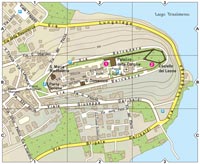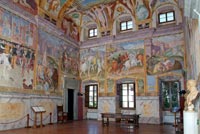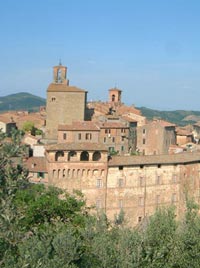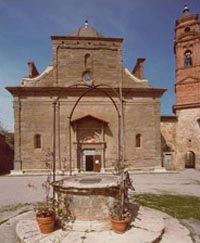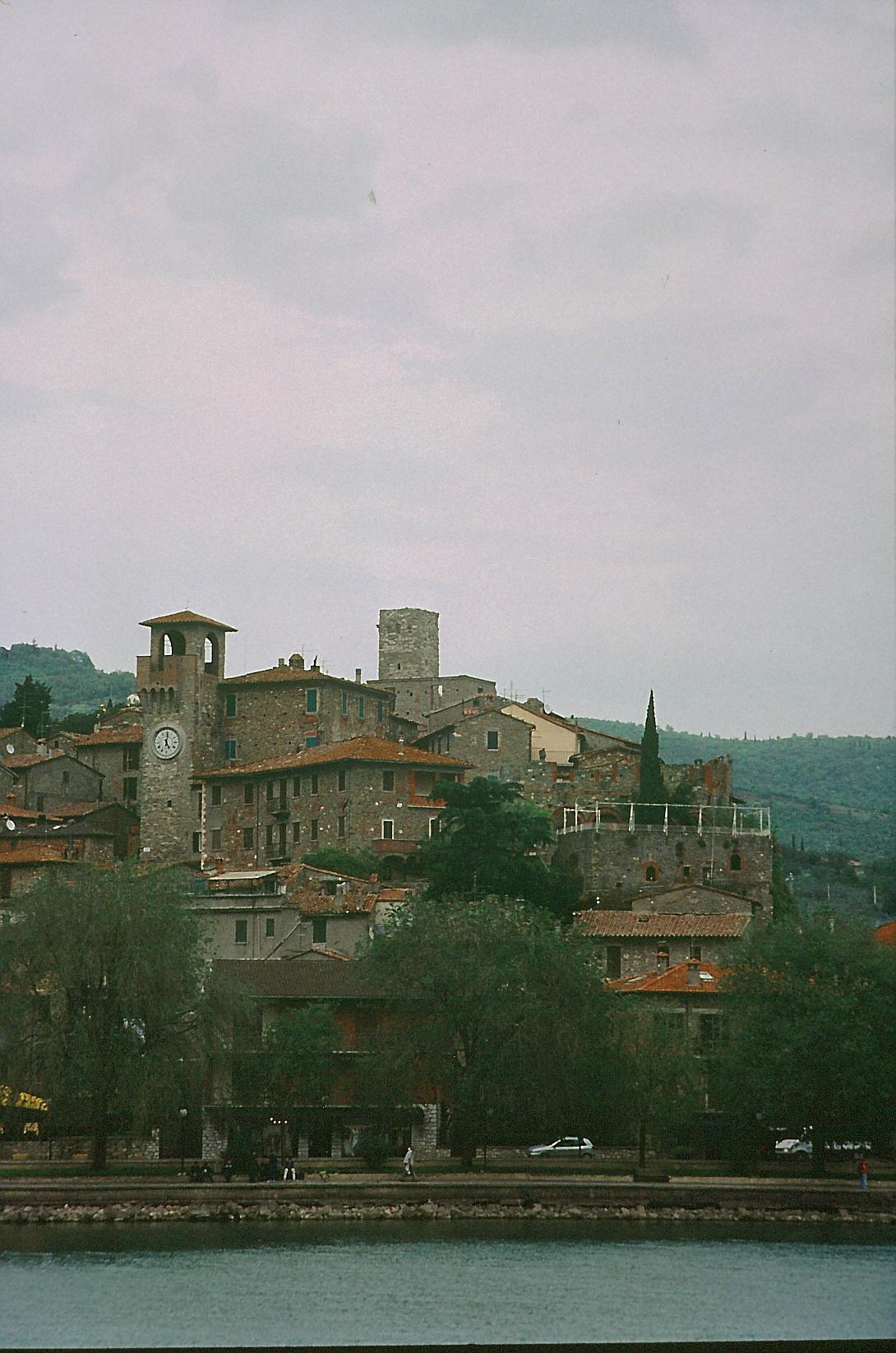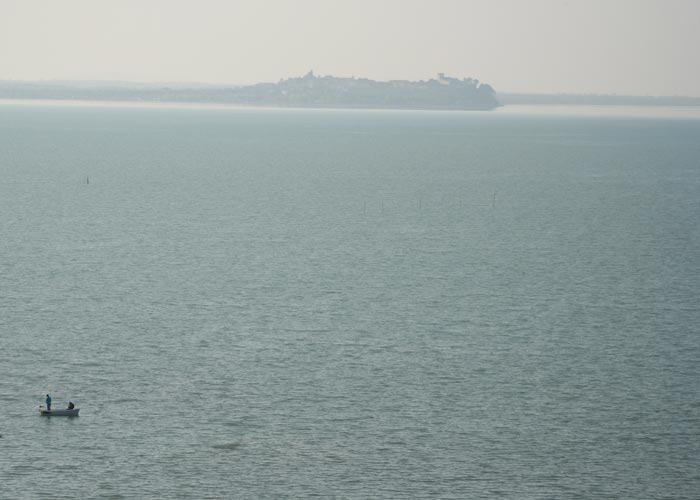 |
|
| Lago Trasimeno |
|
| Castiglione del Lago |
||
The town is a castle, entirely surrounded by its fortified and castellated walls, rises on a promontory, and seems to be launching itself into the waters of the lake like a ship. Its territory includes the Isola Polvese, largest of the three islands in the lake. (Map and other materials published by Umbrian Regional Tourism Board) |
|
|
| The Palazzo del Comune (Town Hall) was built by Ascanio della Corgna in Renaissance style, designed by the architect Vignola. It is now a civic museum and gallery. The palazzo has by a long, covered corridor connecting to the castle. Renaissance era frescoes by the Pescara-born artist Giovanni Pandolfi and the Florentine artist Salvio Savini adorn the main floor inside. In 1574, the artist Niccolò Circignani, known as Il Pomarancio, added paintings and other decorations to one of the most interesting rooms in the palazzo, the so-called Room of the Exploits of the overlord Ascanio della Corgna. The Palace of the Della Corgna family was built in 1563, in consequence of Ascanio 's acquisition of the title of marquis of Castiglione. Conceived as a small royal palace, it was completely isolated from the rest of the village and afterwards completed by luxuriant gardens. At the beginning of the century the Palace gave hospitality to important figures like Niccolo Macchiavelli and Leonardo Da Vinci. The design of the Palace has been ascribed both to Vignola and to Alessi. it is possible tbat they worked on it together. The piano nobile, today the first stage of a visit to the museum, is divided into three main parts: the central one (entrance and three balls) and the eastem one (five rooms) are all frescoed, whereas the western one, with three rooms which were probably for servants, has white walls. A third, northern, hall was used as a theatre with a stage and a gallery and it was in use until after 1920 when it was demolished. Comune | www.comune.castiglione-del-lago.pg.it |
||
| Panicale |
||
| The hill of Panicale, that had once belonged to Etruscan Chiusi, to the Romans and to the Longobards, was particularly important to Perugia in the 13th and 14th centuries, for its strategic position controlling the valleys of the Nestore River and Lake Trasimeno. The origins of Panicale date back to archaic times. As early as 2000 B.C., Indo-European herdsmen called Acherni and Italic people lived on the hill where Panicale is situated. Some 1000 years later, Etruscan farmers took over and were later joined by the Romans. Historians believe that the name Panicale comes from the Latin words Pani calet, i.e. 'to be in the heart of the god Pan', the patron of nature and forests. The names of the surrounding areas and villages are all of Latin origin. They include Gioveto, the god Jupiter, Missiano, the messenger of Janus, and Ceraseto, the place of Ceres. Many more are known. In the 9 C A.D., Panicale was already a castle, and 500 years later, a constitution ruled the life of its people. Its defence walls still stand after numerous wars against Florence, Rome, Perugia, the Vatican State and other neighbouring towns in the area. Panicale overlooks the lake from a natural balcony. It developed in a circular pattern around three piazzas, unusually set in a straight line going up the hill. The lowest is the ancient Piazza del Comune (Piazza Umberto 1). Panicale can be entered through two gates: Porta Fiorentina (1), used when arriving from Florence, and Porta Perugina used when arriving from Perugia. |
|
|
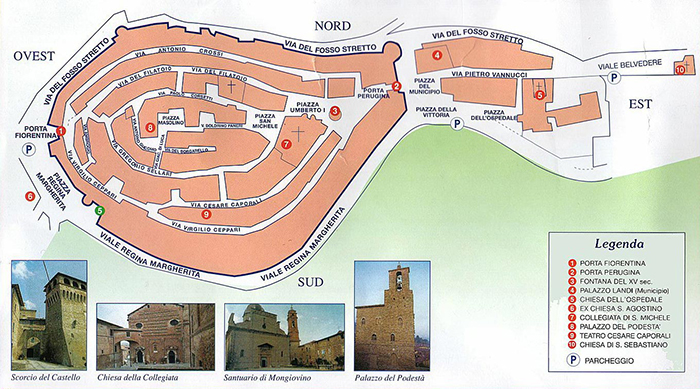 |
||
|
||
| Entering from Porta Perugina, is the ancient Piazza del Comune (Piazza Umberto 1), with the Palazzo Pretorio opposite the handsome travertine fountain (1473). This is the first of three levels on which the village has been developed, each with narrow streets that meet in the square. On the second level you will find a square where there was a concentration of religious power, this square takes its name from the imposing Collegiate of San Michele Arcangelo. Founded by the Longobards, the church was enlarged in the 17th and 18th centuries and sumptuously decorated in the Baroque style. It contains valuable works of art, first of all there is the tablet dedicated to the Nativity by Giovan Battista Caporali, a pupil of Perugino (1519), and behind the high altar, a fresco of the Annunciazione, attributed to Masolino da Panicale, who was the master of Masaccio. Amongst these baroque decorations you can see the recently restored Morettini Organ (1835), together with a sixteenth century wooden crucifix and a painting of the Last supper by an unknown painter from the late eighteenth century. On the same square you will find the House of Giacomo Paneri, best known as Boldrino da Panicale, who was mercenary captain who played an important role in local affairs. At the top of the hill is the piazza with the Gothic Palazzo del Podestà. Outside the Porta Fiorentina(1) are the 13th-century Church of Sant'Agostino (6) and the elegant Church of the Madonna della Sbarra, in the style of the 16th and 17th centuries. From this square you can enjoy a beautiful view over Lake Trasimeno and the border lands between Umbria and Tuscany. Going down through the alleys of the village, you get to the small precious Teatro Cesare Caporali (9), built in XVIII century, it was completely renovated, according to the classical Italian theatre style, with a horseshoe plan, two tiers of boxes and a gallery, by Giovanni Caproni in 1858. Its structure is made entirely of wood and is decorated with stucco medallions. It also preserves a painted curtain by Mariano Piervittori, 1829, representing the delivery of the city keys of Perugia to Commander Boldrino Paneri. |
||
| Just outside Porta Fiorentina, you will get to the sixteenth-century Church of Sant’Agostino (6),which now houses the Museo del Tulle. Inside, you will find the remains of frescoes attributed to the school of Perugino together with a valuable stone altar by Giambattista di Cristoforo da Cortona (1513) which are the framework for typical examples of ars panicalensis handmade embroidery. Art is everywhere in Panicale: just beyond Sant’Agostino, you can admire the elegant façade of the Church of the Madonna della Sbarra (1625), so called because it arose in the place where the custom office was. The high altar is characterized by four huge golden angels, and the building now houses a collection of sacred objects and canonicals. What you have seen so far is just a prelude to the great masterpiece which is housed in this small Umbrian village: a fresco painted by Perugino in 1505, Il Martirio di San Sebastiano, which decorates the back wall of the Oratory of San Sebastiano(10). The Chiesa di San Sebastiano (10) is a small, romantic and extremely beautiful church right outside the walls of Panicale.The magnificent architectural set designed in the background, represents the same landscape that you can see from outside the church, it intensifies the rhythmic gestures and rather than a scene of martyrdom, the atmosphere suggests a theatrical performance, the dance of the archers around the naked and suffering body of San Sebastiano. It represents the gentleness of Renaissance art, interpreted at its best by Perugino, having reached his full artistic maturity. In the same church you can admire a fresco depicting the Madonna in trono con Angeli musicanti, which has recently been attributed to Raphael. The Chiesa di San Michele Arcangelo (7) contains The Annunciation of the Virgin, a fresco made by the famous Renaissance painter Tommaso Fini, also known as Masolino da Panicale (1383 - 1447). He was a friend and possibly a teacher of Masaccio. |
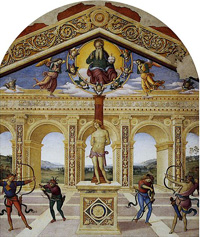 Il Martirio di San Sebastiano |
|
| Not far from Tavernelle, in the Panicale area, is the Renaissance church Santuario di Mongiovino. The central plan with dome was designed by Rocco da Vicenza in the early 16th century. Inside are frescoes by Niccolò Circignani c"and Arrigo Fiammingo. Consecrated in 1646, it contains works by great artists such as Niccolo Circignani, called Pomarancio, Giovanni Wraghe and Hendrich Van den Broeck. To visit, contact: Sig. Valmarini Mauro Tel: 075 832618 The ancient hamlet of Mongiovino Vecchio sits on a pleasant hill behind the Santuario. |
|
|
| Paciano |
||
| Paciano is described by outsiders rushing through it as a sleepy fortified hilltop town, probably because it is Umbria's smallest council with less than a thousand inhabitants spread over its 16 square kilometres. But taking your time, you find it has its share of history and art. The area around Paciano was inhabited by the Etruscans in the 7th century BC, from which the remains of the temple dedicated to Janus still remain. Theories on the origins of its names are many, the oldest ones being Pace di Giano (Peace Of Janus) or Passus Iani (Passage to Janus). Today, Paciano retains its character as a medieval castle, accessible through its three arched gates. Guarding the town are old defence walls and eight towers which in the 17th century were converted to dwellings. Inside the town, three parallel streets connected by picturesque orthogonal alleys hide palaces, old defence structures and churches. The Chiesa di San Carlo, with its beautiful 15th century portals, is regularly used for mass. Paciano's oldest church, Chiesa San Giuseppe, has a painting of the town's Patron, the Madonna of Mercy. In total, seven churches exist both within and outside the town walls. Each containing works of art by local medieval and renaissance artists. The best paintings have been collected into a separate museum, the Raccolta d' Arte di S. Giuseppe, right across from the church of that name. The headquarters of the ancient Confraternity of the Holy Sacrament houses a small art museum that through its exhibits documents the history of Paciano's art, from the Etruscans to the early seventeenth century. The opus of the museum are works by the 13th century painter Francesco Nicolo from Citta della Pieve, believed by many to be Il Perugino's teacher. They include a fresco of the Crucifixion alongside two wood panels depicting saints. These, together with paintings, gold and silver artefacts from the 15th to the 17th centuries, frescos from the 12th, and Etruscan objects from the 4th century BC make a visit to this one room museum worthwhile and amusing. Keys are kept in the house diagonaly across from the museum. Ring on the doorbell to gain access. The important nature area of Monte Pausillo, one of the richest habitats of Mediterranean wild-life, lies in habitats Panicale territory. From its hilltops, an eagle's-eye view takes in three lakes: those of Trasimeno, Chiusi and Montepulciano. Comune | www.comune.paciano.pg.it/ |
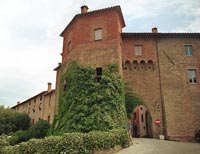 Paciano |
|
 |
||
Hannibal Pathway | Sosta n. 8 del Percorso Annibalico - copia della statua bronzea dell'Arringatore[3]
|
||
| Tuoro sul Trasimeno |
||
| Tuoro is situated in a commanding position on a small hill rising up out of Trasimeno's northern plains, where the famous battle between Hannibal Bacrca's Carthaginian army and Caio Flaminio Nepote's Roman Legionnaires took place in 217 BC. The Way of Hannibal along the Phoenician’s Route The Battle of Lake Trasimeno marked a turning point in the Second Punic War. It was dawn, on the 21st of June 217 BCE, when the Carthaginians, led by Hannibal, defeated the Roman troops under the consul Gaius Flaminius. The landscape around the lake is itself an open-air history museum: visitors can follow a trail, the Percorso Annibalico or Hannibal Pathway, informed by the work of historian Giancarlo Susini, which winds along the scenery of the epic battle between Rome and Carthage. In the Late Middle Ages Tuoro sul Trasimeno witnessed one of the most disastrous and legen-dary battles of ancient times, in which more than 16.000 Roman soldiers lost their lives, wiped out in 217 B.C. by the army of Hannibal the Carthaginian. In the late medieval period t was a large farming village, and from these ancient roots the town's network of alleys, squares and roads remains relatively unaltered today. The surrounding area, on the westernmost edge of Perugia's territory, the route of the main road for Cortona, was overlooked by four castles, the remains of which can still be found at Borghetto, Monte Gualandro and Vernazzano. The most important religious site in the area is the Pieve Confini Abbey (12th century), so-named because it is situated on the borders ("confini") of the Etruscan territory of Cortona and of Perugia. S.Maria Maddalena Church This church became Tuoro's parish church at the end of the 1300s following the ruin of the Church of S.Agata (St.Agatha). Previously, it had been a single chapel, and the baptismal font was not added until 1491. Almost nothing remains og the original church since reconstruction work was carried out in the second half of the 1800s. A striking scene depicting the conversion of Mary Magdalen can be seen in the apse of the church, painted in 1949 by the artist Gerdardo Dottori. Permanent Documentation Centre of the Battle of Trasimeno The Centre, inaugurated in the early months of 1996, brings together a permanent exhibition on the subject of Hannibal and the various theories about the Battle of Trasimeno. The visit to the Documentation Centre is a preparation for following the historic/archaeological route of the Battle. By utilising the various stopping-places along the route, it is possible to identify the areas where the confrontation took place, and to visit the "ustrina", the huge pits which Hannibal had dug to burn the corpses. Campo del Sole "Fiedl of the Sun": this space on the "Lido di Tuoro-Punta Novaccia" is a inspiring open-air museum: 27 sculptured columns form an enormous spiral 44 metres in diameter, leading into a central plinth mounted with a symbolic sun sculpture. The concept for this unique project began with Pietro Cascella working in collaboration with Mauro Berrettini and Cordelia von den Steiner, and work on the Campo began in the summer of 1985 and went on until Autumn 1989. Not far from the town is the Pieve di Confine, a romanesque building of the early XIIth century. Also the Castle of Monte Gualandro (442m a.s.l.) is easily reached. www.comune.tuoro-sul-trasimeno.pg.it |
 Sosta n. 11 del Percorso Annibalico - la colonna romana |
|
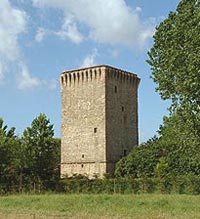 Castello di Borghetto |
||
| Itinerari turistici | Pro Loco Tuoro sul Trasimeno (it) | www.prolocotuorosultrasimeno.it |itinerari.htm |
||
| Piazzetta del Rondò, “Centro di documentazione sulla Battaglia del Trasimeno e Annibale”, chiesa di S. Maria Maddalena, “Percorso Annibalico”. |
||
| Piazzetta del Rondò; “Campo del Sole”, Isola Maggiore e ritorno. |
||
| Piazzetta del Rondò, Castello di Borghetto. |
||
| Piazzetta del Rondò, Castello di Vernazzano. |
||
| Passignano sul Trasimeno |
||
| Passignano sul Trasimeno stands on a small promontory formed by the last spurs of the hills descending down to the northern shore of Lake Trasimeno. The area was inhabited by the Etruscans and the Romans, and is the place where Hannibal and his troops slaughtered and defeated the Romans in the famous Battle of Lake Trasimeno (217 BC). Later the Goths, Lombards and Byzantines also fought for control of the area. The town’s oldest quarter has preserved intact its appearance of a fortified village, which can still be seen today enclosed within the circuit of medieval walls. The gates and towers of the walls have survived, such as the tower known as the Torre di Ponente, which still bears the Commune’s coat of arms. The Rocca, or fortress, rises on the highest point in town. Built in the 5th-6th centuries, it was later enlarged and transformed. Among the buildings of artistic importance are the Church of San Cristoforo, an old parish church built before 1000 AD over the ruins of an older pagan temple, the 15th-century Church of San Rocco, the Church of San Bernardino and the Oratory of San Rocco. There is also the impressive 16th-century Sanctuary of the Madonna dell’Oliveto, which holds excellent paintings and sculptures such as the Madonna and Child in sandstone by Ascanio da Cortona. One place of particular interest is the Boat Museum, where various craft from Lake Trasimeno, Lake Piediluco, and from Padule di Fucecchio are on display, as well as the "Fassoi", a boat made from plants from the Cabras Marsh in Sardinia. Deserving of a visit nearby is the delightful little village of Castel Rigone, with gorgeous views of Lake Trasimeno, where one finds the Sanctuary of the Madonna dei Miracoli, considered a masterpiece of the Umbrian Renaissance. Another interesting place to visit in the surrounding hills is the ruins of the Roman Villa delle Quarantaia, a rustic villa dating from the 1st century AD, and the keep of the old Castle of Monteruffiano. Also just outside Passignano is the 12th-century Church of San Vito, and the 17th-century Villa of the Bourbon Marquises of Sorbello in Pischiello. The entire area has many places of environmental interest: regular boats leave from Passignano for Polvese Island and Maggiore Island, where one can visit the Romanesque Church of San Salvatore, built in the 12th century, and the Church of San Michele Arcangelo (14th century). A fortunate combination of nature and history, art and folklore, Passignano offers a millenary art and architectural fabric that serves as a setting for a number of popular water sports. In Passignano sul Trasimeno, near the office of the Ente Parco, the Boat Museum was created. There can be found some of the crafts typical of the lakes of Trasimeno, Piediluco, Padule, Fucecchio and also the fassoi (a boat made out of marsh plants) of the Cabras Pond in Sardinia. For what concerns the Trasimeno Lake, two types of traditional boats are displayed, used by professional fishermen up to the second half of the 20th century, already present in 15th-16th century. The monoxilo crafts, recovered during the dredging of the lake shores in the area of Passignano, dating back to the 13th century, are the most important specimens of the museum. Comune | www.passignanosultrasimeno.org |
||
| Magione |
||
| Magione stands on the hills on the western side of Lake Trasimeno and is dominated by the majestic castle of the Knights of Malta. The most important building is the Castle of the Knights of Malta, one of the most beautiful in Umbria, which was constructed on a square plane with large round towers and a courtyard that has 3 levels of loggia on 3 sides. The present building, built around the nucleus of the pilgrim hospice founded in the 12th century by the Knights of Jerusalem, is an enlargement of the pre-existing castle that incorporated a Benedictine abbey from the 12th century, thought to have belonged to the Knights Templar. Of interest is the church of San Giovanni Battista, built in 1571, with a majestic Baroque facade and on the inside a fresco cycle by Gerardo Dottori; the church of Madonna delle Grazie (1209) featuring the Vergine in Trono con il Bambino (1371), a painting attributed to Andrea Di Giovanni da Orvieto; the Torre dei Lombardi tower built between the 12th and 13th centuries by the Knights of Jerusalem for defence; and the Palazzo Comunale, town hall, home to frescoes by Gerardo Dottori. In the vicinity worthy of a visit is the medieval hamlet of Montecolognola that gives a wonderful view on to Lake Trasimeno, and the church of Santa Maria Annunziata, the Castle at Agello, the Abbey and Romanesque church at Sant’Arcangelo, and the Museo della Pesca, fishing museum. Situated in San Feliciano, Magione, the Fishing Museum documents the long history of the Trasimeno Lake, describing its main activity over the centuries: Fishing. Inside the Museum, can be found informations concerning the issues related to this craft, along a path which can be framed in a proper, real water culture. www.comune.magione.pg.it |
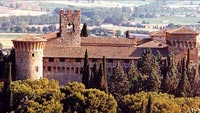 Castle of the Knights of Malta Castle of the Knights of Malta |
|
The islands |
||
| Isola Polvese is a scientific and educational park. The isle is situated in the communal territory of Castiglione del Lago and is the largest of the three, with its 540.000 square meters. It is owned by the Provincia di Perugia and is a public park. Until the fifties the isle was inhabited by a large community, now is deserted. It conserves interesting historical monuments, as the Saint Secondo Monastery, the Church of Saint Julian and a castle of the fourteenth century. A recently built villa, the guests quarters and other buildings are now the seat of scientific educational and recreation activities. The Polvese has been proclaimed by its owner, the Provincia di Perugia, a "Scientific Educational Park" devoted to research, experimentation, formative and educational activities in the environmental field. Itineraries in Polvese Island |
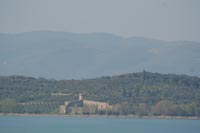 The island with the castle The island with the castleof the 14th century |
|
| Isola Maggiore is the second largest island. It is a frazione of the comune of Tuoro sul Trasimeno, and is the only inhabited island on the lake. St Francis of Assisi lived on the island as a hermit in 1211 during a forty-day sojourn during which he consumed just half a loaf of bread. A chapel marks the point of his disembarkation, and there's a small Franciscan monastery on the southeast shore. The best outing, though is the 12th century Church of Saint Michael the Archangel. Sited at the island's highest point, it's decorated with frescoes and has a Crucifixion painted by Bartolomeo Caporali in 1460. The island's only town reached its height in the 14th century, after the establishment of a Franciscan Monastery is 1328. Most of the towns buildings date from this period. Guglielmi's Villa The Guglielmi castle (Villa Isabella), was built in 1885 on the site previously occupied by the 1328 convent and church of St Francis. Towards the end of the 1800s the marquis Giacinto Guglielmi di Civitavecchia purchased the fourteenth century buildings which had been the monastery and church of St.Francis, and he incorporated them into a sumptuous private residence, built in the form of a castle, to which he gave the name "Villa Isabella". At the beginning of the 1900s, the marquis's daughter Elena encouraged the island women to take up Irish lace embroidery, a tradition not widely known or practised in Umbria, but which remains part of island life for the women today. "Villa Isabella" is now a haunting derelict reminder of its last owner's extravagant plans. |
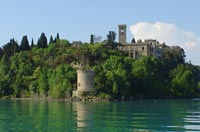 The Guglielmi castle on Isola Maggiore |
|
Isola Minore is the smallest of the three rising from the lake, called isoletta (small isle) until the beginnings of the twentieth century. Now Isola Minore is part of the territory of Passignano and private and deserted. Timetable of the boats: www.apmperugia.it |
||
Servizio Turistco Territoriale del Trasimeno, Piazza Mazzini, 10 , 06061 Castiglione del Lago (PG)
|
||
 |
||
Vista del Lago Trasimeno al Monte Amiata[2]
|
||
| www.sistemamuseo.it/musei.php (it) | ||
| www.lagodarte.com/html/turismo_cultura_musei.php (it) | ||
| www.trasimeno.regioneumbria.eu |
||
Parco del lago Trasimeno is Umbria’s largest regional park. The park was founded in 1995
and is managed by the Comunità Montana - Associazione dei Comuni "Trasimeno - Medio Tevere". |
||
Enlarge map |
||
Badia, Bertoni, Binami, Caioncola, Carraia, Casamaggiore, Castiglione del Lago Stazione, Ferretto, Fratavecchia, Gioiella, Macchie, Mugnanesi, Panicale Stazione, Panicarola, Petrignano del lago, Piana, Porto, Pozzuolo, Pucciarelli, Sanfatucchio, Vaiano, Villastrada and Vitellino are frazioni of Castiglione del Lago. |
||
| Renaissance and Mannerism Painting in Città della Pieve, Paciano, Panicale and Castiglione del Lago |
||
This project is one part of a vast programme created to make better use of the cultural and environmental resources of Trasimeno. |
||
| Walking and Trekking in Tuscany | Circular Walks on the Tuscany Umbria Border |
||
There are several circular Walks on the Tuscany Umbria Border available in Podere Santa Pia. The information contains full instructions for several walks of varying length and difficulty in the stunning border area between Cortona, Lake Trasimeno, Montone and Perugia. The views are staggering: hills and mountains stretch off into the distance and the Lake forms a stunning backdrop to the walk. Ancient towers and castles are dotted along the route and one can visit several of the small towns around the Lake.
|
||
| Castiglione del Lago and the hills between Lake Trasimeno and Tuscany |
||
| This route starts and ends from the sports ground in Castiglion del Lago, situated on the southern short of Lake Trasimeno. Castiglione del Lago’s town centre, with its medieval walls and three ancient town gates, is well worth a visit, and also offers a wonderful view right across Lake Trasimeno just below the town. Buildingi of particular interest inside the town include the Rocca del Leone, an impressive pentagonal-shaped medieval fortress andone of the best surviving examples of military architecture in Umbria, and the Palazzo della Corgna. There are a number of interesting villages situated in the nearby hills bordering Tuscany and Umbria, such as Gioiella, Villastrada and San Fatucchio. Download pdf |
||
| From the river Tiber to lake Trasimeno |
||
[ Umbertide, Colle Campana, Castel Rigone, Passignano, Tuoro, valico Gosparini, Lisciano Niccone, Niccone, Umbertide ] |
||
| From Paciano to Panicale |
||
Paciano is a small hill top town retaining its appearance as a medieval castle. A walk on the Ceraseto Road, connecting Paciano to Panicale is a must, as the views over the Trasimeno Valley are unforgettable. You will come across the Tower of Orlando, the only remains of "Old Paciano", destroyed during one of the numerous wars in the middle of the 11th century. You will also stumble upon the old location where they believed was the location of temple of Janus. The temple was later replaced by a pagan temple dedicated to Ceres, the Roman goddess of Agriculture. Today, the Ceraseto church from the 16th century stands in the very same location. Traces of the reused building materials from the Etruscan temple still visible in the outside walls, including a stone depicting the two faced Janus. On the inside, a fresco by Giovan Battista Caporali. |
||
| Parco del lago Trasimeno is Umbria’s largest regional park. The park was founded in 1995 and is managed by the Comunità Montana - Associazione dei Comuni "Trasimeno - Medio Tevere". Office Park | Viale Europa - Passignano sul Trasimeno (PG). Protect Area | Surface: 13.200 Ha |Perimeter of the Park: 50 Km www.parcotrasimeno.it |
||
| The trail network of Parco del Lago Trasimeno leads you on foot, but also on horseback or by mountain bike, to the hills surrounding the lake, where the several town center face. Some old roads down to the lake have been recovered in order to enhance the environmental features of the Park Municipalities, to improve the accessibility for citizens and tourists, as well as to make better discover the Park, promoting a thorough knowledge of the lake ecosystem: Municipality of Castiglione del Lago - Road down the airport, Municipality of Tuoro S/T - Road down Casa del Piano - Isola Maggiore Road down the town and pedestrian itinerary Sasso di San Francesco, Municipality of Passignano S/T - Road down Oliveto, Municipality of Magione - Roads down Monte del Lago, Municipality of Panicale - Road down Poggio di Braccio and Grottone. |
||
| Itineraries in Polvese Island | ||
| In Polvese Island you can go along three itineraries: Around the island | Walking time: about 1h 30' | Length: 3,5 km The itinerary leaves from the Service Center and heads first to the Castle and then to San Giuliano Church. Walking along the lake shores, you will get to the northern tip of the island. Go ahead along the north-western coast: cross an ilex grove, get to the beach and then, after walking closely to the canebrake, go back to the departure point. |
||
| Historical itinerary | Walking time: about 2h 30' | Length: 3 km Leaving from the Service Center you will get to the Castle and San Giuliano Church. After walking along the canebrake in the southern section of the island, take a trail leading to San Secondo Church and Olivetano Monastery. Going along the ancient Procession Road, you will get to the Garden of the Aquatic Plants and then return to the Service Center. |
||
| Naturalistic itinerary | Walking time: about 1h 3 | Length: 3,5 km | Leaving from the Service Center, walk along the canebrake of the eastern section until you get to the "Tip" of the island. After crossing the beach, enter the wood and then leave it near the ridge. From here, rapidly descend until you get to the departure point, crossing the Garden of the Aquatic Plants. |
||
| Hiking around the Trasimeno |
||
| From Panicale towards the dearly-loved hills of the painter "Il Perugino" |
||
The route starts from the centre of the village, and begins with a steep descent down a newly-laid road, towards Castiglione del Lago and Tavernelle. |
||
|
||
[1] Photo by Adrian Michael [2] Fonte fotograficaFonte fotografica Ziegler175 [3] Photo by Diego Baglieri |
||


 Castiglione del Lago
Castiglione del Lago 